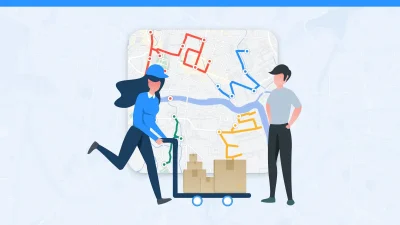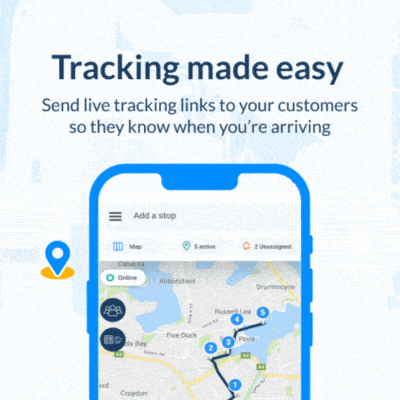The e-commerce industry has grown exponentially over the past several years as a result of consumers opting for an online shopping experience. In doing so, strategies for optimizing last-mile delivery have never been more important.
The difficulty of the last-mile delivery, or the portion of the delivery procedure that takes place from the transportation hub to the customer’s door, is a result of the growth of e-commerce.
Optimizing the last mile is necessary for ensuring goods are delivered successfully, delivery vehicles are being used effectively, while also increasing customer satisfaction.
Challenges of last-mile delivery
Congestion
Particularly in urban areas, traffic congestion is a significant obstacle to last-mile delivery. Delivery times can be greatly extended by congested roads and limited parking, which can result in higher operational costs for enterprises. Unfamiliar neighborhoods can be difficult for drivers to navigate, which can cause further delays.
Delivery Route Planning
Arranging the delivery path presents another difficulty for last-mile deliveries. For drivers to be able to deliver products to several locations quickly, effective route planning is crucial. This can be a difficult undertaking, particularly when sending packages to places with heavy traffic or difficult access.
High Costs of Delivery
Delivering packages the final mile can be costly, particularly when doing so in rural or tiny towns. It can be difficult for firms to remain competitive in the market due to the high delivery costs, which can result in lower profit margins.
Ineffective Delivery Processes
Using last-mile delivery might be difficult when distribution methods are ineffective. Missed deliveries, broken products, and unsatisfactory customer experiences can all result from poorly planned delivery operations. Reduced consumer loyalty, lost revenue, and harm to the reputation of the business can all result from these inefficiencies.
Security
Another difficulty with last-mile delivery is ensuring the safety and security of the packages. Packages may be at risk of theft or damage while in transit, which could result in unhappy customers and financial losses for businesses. Also, when sending packages to new locations or in dangerous regions, drivers may run the chance of being hurt.
Strategies for optimizing last-mile delivery
- Making use of data analytics
Using data analytics to improve last-mile delivery is crucial. In order to make informed judgments concerning last-mile delivery, businesses can utilize data to study customer behavior, delivery patterns, and traffic patterns, among other things.
- Putting Delivery Route Optimization into Practice
Delivery route optimization is the process of employing technology to find the most effective path for sending products to numerous locations. Delivery times can be cut in half with this tactic, while operational effectiveness and costs can all be raised.
- Investing in Last-Mile Delivery Technology
Using autonomous cars and drones to transport packages can dramatically cut down on delivery times, boost operational effectiveness, and save costs.
- Using Third-Party Logistics Providers
Third-party logistics companies can help businesses optimize last-mile delivery by providing specialized delivery services, reducing operational costs, and improving delivery times.
- Establishing a Local Delivery Network
By facilitating more effective and efficient package delivery, local delivery networks can assist organizations in optimizing last-mile delivery operations.

Benefits of optimizing last-mile delivery
Enhanced Efficiency
By streamlining the delivery process, optimizing last-mile delivery can enhance delivery efficiency. To find the most effective delivery routes, businesses might use technologies like data analytics, artificial intelligence, and route optimization tools. This can shorten delivery times, remove pointless detours, and enhance consumers’ overall delivery experiences.
Cost savings
Businesses can reduce costs by optimizing last-mile delivery. Business operations can be made more cost-effective by shortening delivery times and optimizing the delivery procedure. Moreover, outsourcing delivery services can help firms cut expenses by working with third-party logistics suppliers.
Increased Customer Satisfaction
By offering a more dependable and effective delivery experience, optimizing last-mile delivery can increase customer satisfaction. Consumers want delivery services that are quick and dependable, and businesses can meet these demands by maximizing last-mile delivery. Businesses can improve the general consumer experience and foster brand loyalty by offering precise package tracking, cutting delivery times, and offering dependable delivery services.
Competitive Advantage
Businesses in the e-commerce sector can gain a competitive edge by optimizing last-mile delivery. Businesses must set themselves apart from their rivals in the face of escalating market competition. Businesses may draw in more clients and get a competitive edge in the market by providing quicker and more effective delivery services.
Challenges in implementing strategies for optimizing last-mile delivery
Restricted Infrastructure
Businesses face substantial obstacles when putting last-mile delivery optimization methods into practice because of limited infrastructure. Inadequate road networks, a lack of parking spaces, and other infrastructure issues are particularly detrimental to urban regions.
Businesses may find it challenging to efficiently and promptly deliver packages due to these infrastructure limitations. Also, the lack of infrastructure may cause traffic congestion, which makes delivery issues even more difficult.
High implementation costs
Putting last-mile delivery optimization methods into practice can be pricey. Companies may need to make expensive investments in new technology like delivery management systems, route optimization tools, and data analytics.
To implement these techniques, firms may also need to recruit more personnel or collaborate with outside logistics suppliers, which will raise the overall implementation costs.
Limited Access to Customer Data
Another challenge in implementing last-mile delivery optimization ideas is having restricted access to consumer data. To maximize last-mile delivery, businesses need access to client data such as delivery addresses, package sizes, and delivery preferences. Consumers could be reluctant to share this information because they worry about their privacy, which makes it challenging for businesses to maximize last-mile delivery.
Lack of Standardization
Due to the lack of standards in last-mile delivery, businesses may experience problems. Different delivery providers may have varied delivery standards, which could lead to inconsistencies in the delivery process. Due to inconsistency, especially when working with several delivery vendors, businesses may find it difficult to maximize last-mile delivery.
Security and safety concerns
It can be challenging to keep packages safe during last-mile delivery. Businesses must ensure that deliveries are made to the correct recipients and that no goods are stolen or misplaced in route. Because delivery drivers may face safety risks while delivering goods to unidentified places or in unsafe areas, it might be challenging to maximize last-mile delivery.
Conclusion
Businesses that operate in the e-commerce sector must optimize last-mile delivery. Businesses can increase operational effectiveness, lower operational costs, and boost customer happiness by putting techniques like data analytics, delivery route optimization, and last-mile delivery technologies into practice.
Even though putting these techniques into practice may be difficult, businesses that want to compete in the E-commerce sector must give optimization of last-mile delivery top priority. A business can eventually fail if last-mile delivery is not optimized because of diminished client loyalty, decreased profitability, and other factors.

The ultimate solution for last-mile delivery optimization
If you want to lower last-mile delivery costs and improve supply chain business processes, Locate2u can help.
Both small and large businesses can increase productivity, and customer satisfaction, and streamline last-mile deliveries with the help of Locate2u’s field and fleet management solution.
Locate2u has everything you need, from route optimization software to real-time visibility, delivery confirmation, and driver ratings.
Learn more about how Locate2u can enhance your last-mile delivery performance and meet customer expectations by clicking here.














